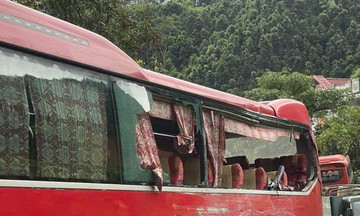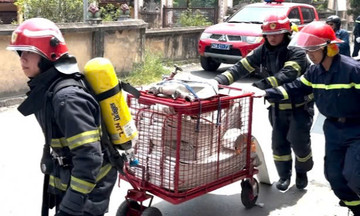Affected by a low-pressure trough, northern Vietnam has experienced heavy rainfall since last night. Rainfall totals from 9 a.m. on 14/8 to 8 a.m. today reached 181 mm in Cat Ba (Hai Phong), 171 mm in Phong Coc (Quang Ninh), 117 mm in Gia Binh (Bac Ninh), 115 mm in Khuon Ha (Tuyen Quang), 114 mm in Binh Gia (Lang Son), and 109 mm in Thach That (Hanoi).
The National Center for Hydro-Meteorological Forecasting predicts that from tonight until 17/8, the eastern part of northeast Vietnam, Lao Cai, Thanh Hoa, and Nghe An will see widespread rainfall of 60-130 mm, with some areas exceeding 130 mm. The northwest region will receive less rain, between 20-40 mm, with isolated areas reaching over 80 mm.
On 17/8, Ha Tinh and Quang Tri provinces are expected to experience widespread rainfall of 20-40 mm, with some areas exceeding 80 mm.
 |
Border guards in Quang Tri province are stationed at a ford in Dakrong district. Photo: Van An |
Border guards in Quang Tri province are stationed at a ford in Dakrong district. Photo: Van An
The central highlands and southern Vietnam are also forecast to experience rain over the next two days, with totals ranging from 50-100 mm, and some areas exceeding 200 mm. The eastern regions of Khanh Hoa and Lam Dong will see rainfall between 20-40 mm, with isolated areas receiving over 100 mm.
Meteorological authorities warn of a high risk of intense rainfall exceeding 100 mm in three hours. Rain in northeast Vietnam and the Thanh Hoa to Quang Tri region is expected to persist until 18/8.
The heavy rain creates a high risk of landslides in 240 communes across several provinces, including Cao Bang, Tuyen Quang, Dien Bien, Lai Chau, Son La, Lao Cai, Thai Nguyen, Lang Son, Quang Ninh, Bac Ninh, Phu Tho, Hai Phong, Thanh Hoa, Ha Tinh, Quang Tri, Hue, Da Nang, Quang Ngai, Gia Lai, Khanh Hoa, Dak Lak, Lam Dong, Dong Nai, and Tay Ninh.
The Ministry of Agriculture and Rural Development has instructed provinces in northeast, central, and southern Vietnam to closely monitor the heavy rain, deploy rapid response teams to inspect riverside and streamside residential areas, and areas at risk of landslides and flash floods, to prepare evacuation plans.
The ministry also directed local authorities to assign personnel to guard, monitor, and provide support at fords, deeply flooded areas, areas with strong currents, and areas where landslides have occurred, preventing residents from passing through.
Gia Chinh
See detailed weather forecast here.












